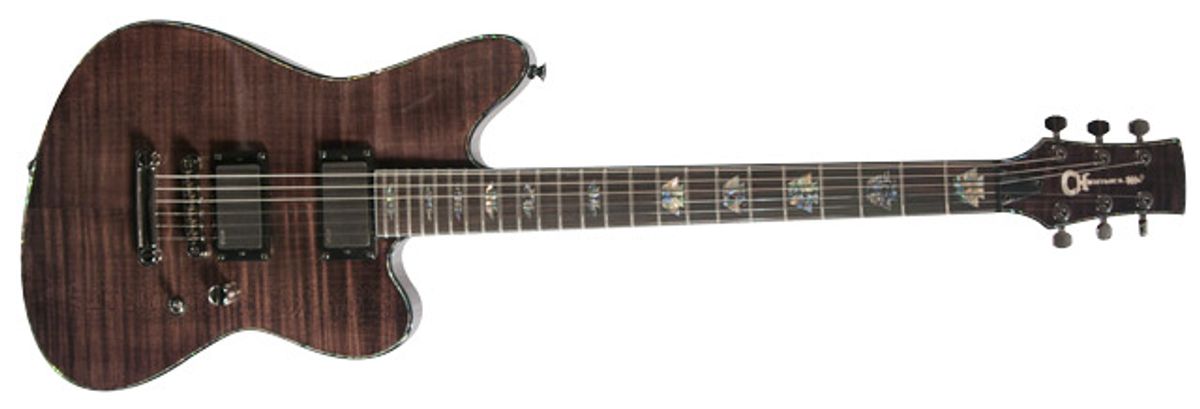
With the introduction of Charvel’s new Desolation series, the Surfcaster’s cool visual lines were reborn in the new Skatecaster model.
Among Charvel guitars, the Surfcaster is something of an odd stepchild. Introduced in 1991, it was targeted at players who loved jangly clean tones from the ’50s and ’60s, which it achieved with a combination of a semi-hollow body, bolt-on neck, and Chandler lipstick pickups. The sonic and visual synthesis of Jazzmaster, Rickenbacker, and Danelectro influences attracted shoegaze-obsessed players and humbucker-equipped versions found favor among heavy players including Scott Ian of Anthrax. The guitar was discontinued in 2005 and became a prize among collectors not long afterwards.
With the introduction of Charvel’s new Desolation series, the Surfcaster’s cool visual lines were reborn in the new Skatecaster model. This time, however, there are few concessions for the retro set or dream pop songsters. This incarnation definitely seems a little more out for blood.
Back From the Grave
The Skatecaster’s offset body is comprised of two pieces of solid mahogany glued to a mahogany neck using a neck-through build. Instead of an array of lipstick pickups like you would have found on earlier versions of the Surfcaster, the Skatecaster employs two EMG active humbuckers—an 81 in the bridge and an 85 in the neck—with high amounts of molten output. The controls for the pickups are few—only a single volume knob and a three-way switch—and they feel solid underneath the fingertips. While the Skatecaster is designed with simplicity in mind, a tone control still would have been a useful addition that wouldn’t hamper the movement of the picking hand, and would offer a degree of control over the EMG-81’s characteristic razor-sharp high end. A black nickel stoptail bridge keeps the strings taut, and was specially designed by Charvel for the neck’s compound radius rosewood fingerboard.
The neck itself is home to some of the most unique features of the guitar. First, it’s bare mahogany, which has a very different feel than the maple unfinished necks that are the most common. The major difference is in the texture—and in the case of the Skatecaster, the mahogany neck feels just a bit less smooth than a maple one. And it could have used a little more finish work and grain filler along the middle section. But while it took me a little while to get used to it, the softer, more porous texture started to feel a lot more comfortable.
The folks at Charvel chose to stop the finish going into the unfinished neck with a hard edge, and it would have felt more natural to have it taper. But otherwise, the Skatecaster was encased in a flawless transparent black finish with a maple veneer top, along with some serious abalone binding and inlay work—not to mention a gorgeous two-ply neck binding job along its 24 frets.
All the Rage
The Skatecaster is a serious metal workhorse. With a 2011 Mesa/Boogie Multiwatt Dual Rectifier into an Emperor 4x12, the guitar screamed during structured leads and growled with every palm-muted gallop that I threw its way. EMG’s 81 bridge pickup has a very focused tone, and with the Mesa and the Skatecaster’s highly resonant body, I was able to coax out thrash tones with ease. The 81 does have a rather intense high end frequency response, which again, made me question the lack of a tone knob on the guitar. Sometimes the highs were just simply too piercing. Granted, I was able to tweak the amp a little to dial most of it out, but it would have been a lot easier—and more effective—to accomplish it directly from the guitar itself.
The active nature of the 81 and 85 prevent any real volume knob cleanup, too. Dropping the guitar’s volume to clear out grit could leave the amp a little sputtery. The Mesa’s clean channel was a fix, but I prefer the classic method and more natural sound of cleaning up the tone from the guitar itself and it’s difficult to do with the Skatecaster, which had more of an all-or-nothing attitude. On the clean channel, the 85’s classic, balanced tone was breathy and wide, with excellent sustain in the low end.
The Skatecaster is one of the most balanced instruments that I’ve played in a while. It sat perfectly on my thigh when I sat down to play. The neck joint is set in a little deeper than most guitars, so the high frets were incredibly easy to reach because they were right in front me the entire time. This makes the guitar feel a little smaller than it really was, but I had no problem getting used to the feel. I had the same success when I stood up and strapped it on—the balance was out of this world, and the fret access is effortless.
The Verdict
As a modern take on one of Charvel’s most interesting models, the Skatecaster offers up some very unique flavors. The bare mahogany neck is a really cool feature that most players probably have never experienced, and the finish work is outstanding—though the hard edge to the finish may throw some people. If you’re into metal, the tones are certainly there, but you might find yourself tooling around with the Treble knob on your amp if the highs become too much for you. For metal and rock players looking for something new that don’t mind working with a wide-open, pedal-to-the-metal approach, this speed demon might just do the trick.
Buy if...
razor sharp metal tones and a unique look and feel are up your alley.
Skip if...
you need a guitar with a more natural response, or one with a tone control.
Rating...
Street $649 - Charvel Guitars - charvel.com |

